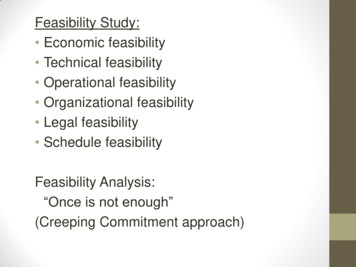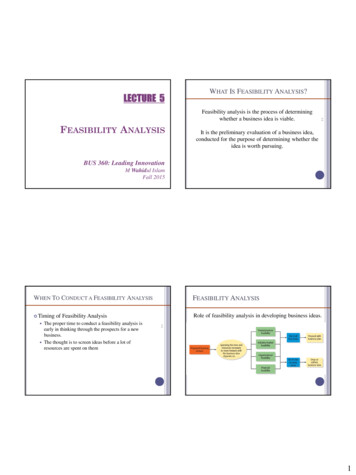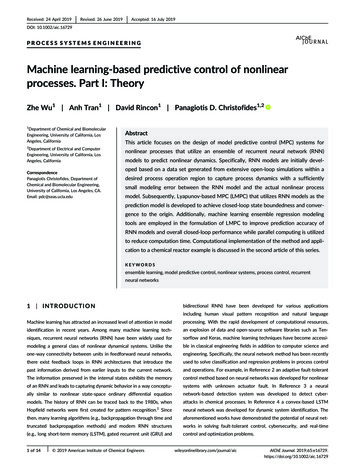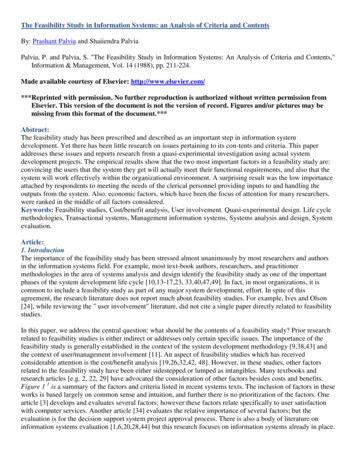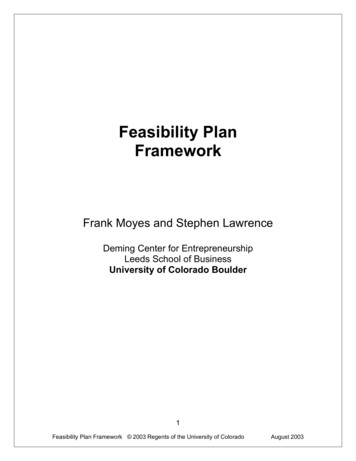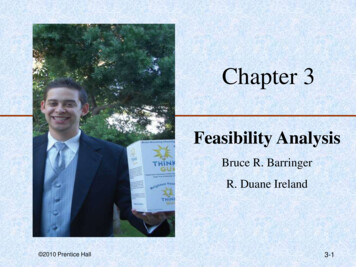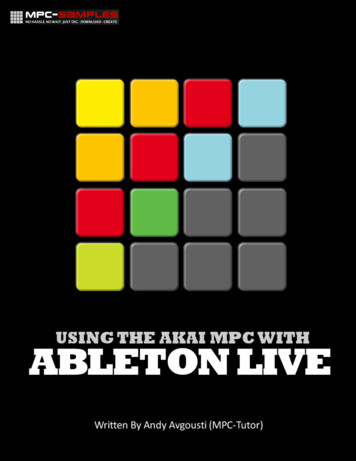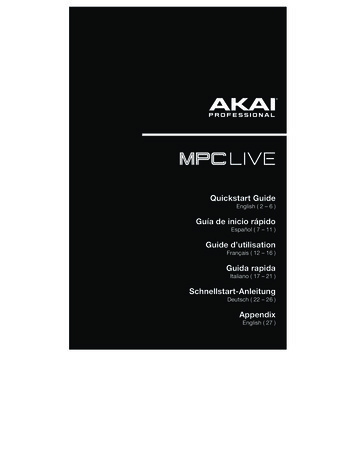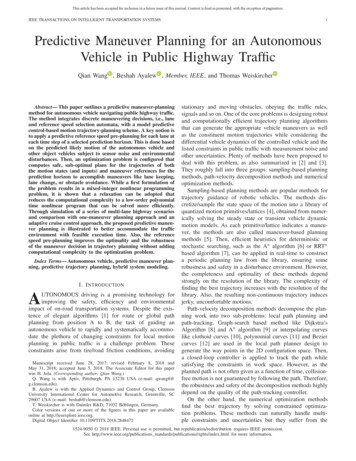
Transcription
Feasibility Study - Summary ReportMBBAssociation- Project Definition
DieseProjekt - Definitionist ein Auszug aus dem Summary Report (Kapitel B1) »dokumentiert denProjektstand zum Ende der Feasibility Study und gilt als:MPC 75Issue 2 (07/87)Ref.: TE15 - 114/87Project Information
MBBAssociatlonLIST OF CONTENTS1.INTRODÜCTION2.REVIEW OF ACTIVITIES3.DESIGN REQUIREMENTS4.BASELINE AIRCRAFT5.ALTERNATIVE CONFIGURATION WITH PW-ALLISON 5O1-M80E6.ADVANCED TECHNOLOGIES7.ENGINE CHOICE8.COMPETITION9.ECONOMICS10.CONCLUSIONSLIST OF APPENDICES
MBBAssoclationINTRODUCTIONThis report summarizes the study results jointly obtained by MBB and CATIC with regardto the technical feasibility of the MPC 75.The Memorandum of Understanding between CATIC and MBB stated the following objectivesfor Group B "Project":"Determine technology readiness Status and define any needed technologicaldevelopments to enhance the success of the programme.Develop preliminary aircraft sizing and configuration options and performappropriate trade-off studies so äs to narrow the many possible options toa sinailer group of most promislng ones".Questions related to the organizational problems of a cooperation were at first covered inGroup B also, but later on they gained such importance that the formation of dedicatedWorking Groups (B2 "Organization and Procedures", B3 "Quality Assurance and Certification",64 "Standardization") became necessary. The Group dealing with technology and aircraftconfiguration was then designated Group B1 "Project Definition".This report covers the work of Group B-\. The main results can be summarized äs follows: The world-wide market study indicates the requirements for an advanced regionalpassenger aircraft with a capacity of approx. 75 seats, having a design ränge of1500 .m., cruise speed of approx. M 0.75 and an initial cruise altitude of notless than 35000 ft.«The baseline configuration of the MPC 75 is designed to meet these requirementsIt incorporates two rear-mounted ultra by-pass engines for propulsion and utilizesadvanced technologies in aerodynamics, materials, and Systems for improved comfort,operational flexibility and superior economics.Bl-l
MBBAasociatlonINTRODUCTIONThe MPC 75 baseline configuration has a four abreast cabin cross section. With32 inches seat pitch, the capacity of a single class layout is 76 seats- With 30inch seat pitch in a high density layout, the seating capacity is increased upto 84 seats.The performance analysis ahows that the baseline configuration meets all technical and market requirements, including the ciritical mission of Kunming-Chengdu.The MPC 75 is very competitive in terms of block fuel and direct operating costcompared with the existing aircraft of the same class.The engine availability study shows tha.t only the QE38 UDF is a suitable candidatepowerplant so far, but the PW-Allison 5Q1-M80E engine and other alternatives arestill under consideration.The results of the feasibiüty study demonstrate that the MPC 75 aircraft is technica.lly feasible, but further refinement of the baseline configuration is stillnecessary. Especially the requirements of potential customers must become betterknown, and must be reflected in the final configuration.R1 -
MBBAsaoclatlon2.REVIEW OF ACTIVITIES2.1Way of workingMBB and CATIC discussed and agreed the overall work plan, and performed the study in closecooperation.Typically, detail work was done independently in the parent companies; results were exchanged in the context of a General Meeting; conclusions were then drawn and detail workplans were established covering the period up to the next meeting. However, on twooccasions, CATIC engineers stayed at MBB in Hamburg for an extended working period äs theStatus of work required so.2.2Main lines of actionInitially, three actions were carried out in parallel: assessment of technical requirements(derived from market needs), assessment of Status of technology, and comparison of methodology (using an example aircraft). A Baseline Aircraft was then defined, and was optimizedand refined by means of parametric variations, trade-offs, and some analysis of criticalcomponents and Systems. This Baseline Aircraft was used in presentations to selected airlines (CAAC, LH), thus stimulating a first market reaction to MPC 75.The question of propulsion/engine availability was dealt with äs a priority item, and regulär contacts with engine manufacturers were maintained.2.3Major Events26.1.86 to 6.2.86HamburgTime schedule and work procedure of Group B agreed.Example aircraft selected to check consistency of engineeringmethods of MBB and CATIC.
MBBAssoclatlon13.3.86 to 25.3.86 First results of example aircraft study discussed.Xian Preliminary Information of operational requirements from CAAC.26.5.86 to 6.6,86 Discussion on example aircraft continued.Hamburg General configuration of Baseline Aircraft agreed. Main design requirements agreed. Visit to CIMBER airline .and European ATC authorities by jointMBB/CATIC team.20.9.86 to 28.9.86 Example aircraft exercise completed, good agreement achieved.Xian Analysis of baseline configuration and trade-offs presented anddiscussed. Possible advanced technologies and benefits identified and listed Part of MBB delegation visits CARDC. Baseline configuration improved (Revision 1) Wing area Variation allowing for the baseline and stretched Version Contribution to airline presentation brochure.24.11.86 to 19.12.86Hamburgni
MBBAssoclatlon23,2.87 to 13.3.87 Baseline configuration finished for feasibility study. Results of alternative configuration with. PW-Allison enginereviewed. Feasibility of advanced structure (CFRP wing box) and advancedaerodynamics (NLF) discussed, conclusion positive. Major Systems discussed, suitable Solutions identified. First contact with 13 European airlines established to improveinformation on design requirements.«First draft of Technical Description available.Hamburg22.4.87 to 30.4.87Hamburg13.5.87 to 20.5.87Summary Report drafted and agreed.Guilin2.4General ResultsThe work carried out in 1986/87 has demonstrated that engineers from CATIC and MBB areable to cooperate succesfully in defining an aircraft, despite still existing problemscaused by the large distance and part-lally insufficient communication lines. A very highdegree of agreement was achieved in all technical matters covered. Discussions and workingsessions took place in 'a professional, matter-of-fact, but open and friendly atmosphere.
MBBAseoclatlon3.DESIGN REQUIREMENTSBaalc market requtrements obtained frorn the Market Group were translated into a set ofDesign Requirements, see Fig. 3.1. In general, performance requirements stated are similarto the level of contemporary regional airliners.The nature of this inforroation is still very preliminary and limited. More substantiationis highly deairable in order to establish a better yardstick against which the aircraft canbe compared.The only specific roission requirement so far was that indicated by CAAC: A flight fromKunming to Chengdu, involving high, elevation, high temperature airfield performance, seeFig. 3.2.In order to improve the Situation on the requirements side, some additional information wascollected froro a limited number of European airlines, on the basis of initial, generalcontacts. These contacts are not fully representative; in addition, uncertainties exist onthe operator's side because the effect of the anticipated liberalizatiön and the changingenvironment in Europ'e is not yet fully assessable.Neyertheless, from this information and the latest inputs received from local administrations of CAAC, the following preliminary conclusions may be drawn:There is some confirmation of the Basic Project Requirements, but on the other handthere appears to be a trend towards a requirement for increased passenger capacity,more cabin comfort, and less ränge.
MBBAssociallonFig. 3.1:SUMMARY OF DESIGN REQUIREMENTSCapacityStart with 75 seats, 32" pitch single class. Stretch potential to 10Oseats, 32" pitch single class. (Later indication: There is the possibility that the above single class recommendation could change tobusiness/economy mixed class with the same number of seats).Range150O nm with füll passenger load, but without cargo; provisions forfuture increase.Cruise speedAbout M 0.75One engine inoperative ceiling16000 ft, ISA -f 10Take-off fieldPerformanceC6000 ft SL, -f ISA 18C, MTOW5200 ft SL, ISA, MTOW6900 ft, 650O ft elevation, ISA, MTOWFAR landing fieldlength430O ft SL, wet runway, Typ. miss. L.W.NoiseFAR part 36 stage III or betterComfortSimilar to F28, (Later recommendation: Perceptive äs well äs physicalStandardcomfort level not worse than the 1990's 100-t-seater single-aisle aircraft; aisle width should consider unobstructed passenger movementswithin the cabin during galley service; airline inputs needed.)EconomicsDOC Target: SMC better than current aircraft of the same category;SMC at least equal to F100 with 100 passengers.Bl-7
MBBAasoclatlonBASELINE AIRCRAFT4.1GeneralA Basellne Aircraft configuration was defined, fulfilling the initial design requirements.It must be understood that the Baseline Aircraft is by no means the final solution. It israther a preliminary solution which fits the market needs and is well enough engineered tomatch technical needs äs well.Hence, the Baseline Aircraft can be reasonably used for checks against requirements orcorapetition aircraft and to indicate the attainable level of payload flexibility, comfort,performance, and economics.Also/ it serves äs a starting point of optimization and refinement, and it helps to stimulate reactions from potential customers.4.2Configuration'GeneralThe Baseline Aircraft configuration, äs far äs possifale, reflects the market needs andtechnical possibilities äs seen today. The configuration has been optimized for the basiccapacity of approx. 75 seats. However, there is an inherent capability for future growthto increased capacity and extended ränge.The Baseline Aircraft reflects the Standards typical of main line operators. New technologies have been incorporated where they are expected to be cost effective (see chapt. 5),
MBBAssoclatlonBASELINE AIRCRAFTWjLngThe planform and profile of the clean wing without leading edge devices were chosen tomatch the aerodynamic requirements for natural laminar flow. The single-slatted Fowlerflaps are used for high lift and to vary the wing camber in accordance with flightconditions. The wing takes füll advantages of the strengfch and stiffness of its compositestructure to minimize induced drag through a high Aspect Ratio and to save weight.FuselageA four-abreast cross-section was chosen for Optimum cabin flexibility with access at frontand rear. The cross-section provides for high passenger comfort Standard and ample underfloor capacity for baggage and some revenue cargo.PropulsionThe General Electric GE38 UDF is considered äs the prime engine candidate. In consequenceof the pusher engine configuration and from consideration of noise and noise fatigue, theengines are arranged at the rear fuselage. See also Chapter 7 "Engine Choice".EmpennageIn consequence of the engine position, a T-tail fin-stabilizer arrangement has been chosen.Figures 4.1to 4.8 present main features of the MPC 75 Baseline Aircraft.R1-10
MBBAssoclatlonBASELINE AIRCRAFT4. 3WeightsThe weights refleqt the latest Status of the Baseline Aircraft definition and includeeffects of using advanced materials and manufacturing techniques. There is confidencethe level of weights is realistic äs they are justifiable against existing aircraft ofsame class. Some weight reduction appears possible äs the aircraft definition becomesspecific. See Weight Summary, Fig. 4.9.thethatthemore4.4PerformanceThe Baseline Aircraft performance reflects the best aerodynamic qualities - including natural laminar flow - that can realistically be assumed at the present state of technology andaircraft definition. Engine data have been used äs furnished by the manufacturer. See Fig.4.10 for the Performance Summary and Fig. 4.11 for Payload-Range.All performance requirements are met or even bettered. Only the "high altitude T.O. case"(690O ft field length at MTOW, 650Q ft elevation) is not met: this T.O. field can only beachieved at a reduced T.O. weight giving a ränge with 76 passengers of 750 nm. Whether thisis significant, or can be tolerated, can only be clarified through contacts with potentialoperators. It should be noted that the only well defined "hot and high" case is fulfilled:the Kunming-Chengdu mission can be flown even under the most adverse conditions.4.5Stretch PotentialA preliminary study has been made on the Stretch potential of the MPC 75. It was found thata stretch of up to approx. 100 seats (äs stipulated by the design requirement) would befeasible. For this Version, MTOW will increase to approx. 34000 kg, and engine thrust mustgrow by some 25 - 30 %. This thrust growth just about appears to be possible for the GE38UDF äs a longer term development. This implies increased engine weight and dimensions. Bothfrom thrust availability and from airframe structural reasons, stretched versions must beconsidered äs mid-to-longterm developments.ni-11
ossz.NOIiVHflDIvEtNODUO B 3O»yBfETIAIU "fr
MBBAssociatlonFig. 4.2:MAIN DATASEATING CAPACITYGEOMETRYENGINERUNWAY LOADINGAll Economy 32"76Mixed Class 32"/36"69High Density 30"84Length, Overall32,05 mHeight, Overall7,55 mSpan28,59 mWing Area75,00 m2Wing Aspect Ratio10,90Wing Sweep17TypeUHBDesignationNumberGE38-B5UDF2Thrust SL. ST. INST.9620 IbACN (flexible and rigidrunway, medium subgrade)16deg18nl-1 3
MBBAssoclatlonFig. 4.3:FUSELAGE CROSS SECTION33U.5B1-M
MBBAsaoclationFig. 4.4: CABIN CROSS SECTION508.00(20.0 IN) L59.30.-.25.4.1159.3025.41n;11\ /1\TOURIST CLASS4 ABREASTAISLE WIDTH 19"NOMINAL SEAT WIDTH 42"FIRST CLASS3 ABREASTAISLE WIDTH 2 3 . 7 "NOMINAL SEAT WIDTH 50"Bl-15
MBBAaaoclatlonFig.4.5:CABIN LAYOUTALL TOURIST76 SEATSGLAC32' PITCHGALLEY(4X TROLLEYS)LAVATORY(2X)ATTENDANT-SEAT (2X)PDA T STOWAGE(2X)20357801 .534" , 38" ,19". 18!-hh18X32" 26-(602")5"39"--G-AITYPE I DODR (72"X32")ILH/RH)TYPE I QDOR (72-X32")(LH/RH)
MBBAssociationFig.rabin Layout4.6:MIXED CLASS9 SEATS 36" PITCH60 SEATS 32" PITCH69 SEATS TOTALGLACGALLEYLAVATORYATTENDANT-SEATCOAT STOWAGE(5X TROLLEYS)(2X)(3X1 2X)20357801 .534" . 38" .20i-F9.sRH2X36" 27.5"(99.5")7" 18."14X32" 26"(474")1--G--AI.jAITYPE I DOOR (72-X32')(LH/RH)A 01.027.03 87TYPE I DOOR 72"X32")(LH/RH)R1-17
MBBAssociatlonFig.Cabin Layout4.7:HIGH DENSITY84 SEATSGLAS30 PITCHGALLEYLAVATORYATTENOANT-SEATSTOWAGE(4X TRDLLEYS](2X)(2X)(2X)20357801 .534' . 38"0--G-20X30'3',J' 37'-HT- GHiLTYPE I DOOR (72"X32")(LH/RH)A01.0?8.0387TYPE I DOOR (72'X32"1(LH/RH)Bl-18
MBBAssoclatlonFig. 4.8:CARGO 1L1"/ § § § DOOR NO. t950x900DOOR NO. 2950x9005.6 CU.MREVENUECARGO5.0 CU.MBAGS2SJ3 §—er!A.6 CU.MBAGS
MBBAssoclalionFig. 4 . 9 :WEICHT SUMMARYWEICHT SUMMARY'Max. Take-off Weight30000 kgMax. Landing Weight28500 kgMax. Zero Fuel Weight27325 kgOperating Weight Empty18825 kgManufacturers Weight Empty17293 kgMax. Payload8500 kgMax. Fuel Capactiy6150 kgBl-20
MBBAssociationFig.4.10:PERFORMANCE SUMMARYREQUIREDACHIEVED15001500REMARKSRANGE WITH FÜLL PASSENGER LRC(nm)RANGE WITH MAX FUELLRC(nm)FAR T.O. FIELD LENGTHSL, ISA, MTOW(ft)52OO5100METSL, ISA 18, MTOW(ft)6000570065OO ft, ISA, MTOW(ft)690097OOMETRequirement met only atTOW for 750 nm RangeSL, WET RUNWAY(ft)43004200FAR LAND. FIELD LENGTHAT TYP. MISS. LWASSOCIATED APPROACH SPEED2500MET(kts)-115--36000-INITIAL CRUISE ALTITUDE500 ft/MIN, M 0.7(ft)1-ENGINE-INOP CEILINGISA 1O C(ft)MAX. CRUISE MACH NUMBER(35000 ft)MISSION KUNMING - CHENGDUMET1600016500MET0.750.76METsee Fig.3.2METBl-21
MBBAaaoclatlonFig. 4.11:PAYLOAD-RANGEPAYLOAD [kg]12000200nm ALTERNATE30 MIN HOLD5% BLOCK GE [nm]Bl-22
MBBAssociation5.ALTERNATIVE CONFIGURATION WITH PW-ALLISON 501-M80E ENGINEA study was made on the PW-Allison engine äs an alternative to the basic GE38 UDF. Formatching the Baseline Aircraft configuration to the PW-Allison engine, the philosophywas to keep the wing position constant relative to the aft pressure bulkhead, and tobalance the high engine weight by inserting a fuselage section in front of the wing andto match the tail size accordingly, see Fig. 5.1 and 5.2.Compared to the Baseline Aircraft there is a larger passenger and cargo capacity, and theweights in general are higher. On the field performance side there is some benefit on takeoff, due to engine thrust but there is some penalty on landing due to higher wing loading.In terms of block fuel there is some increase in trip fuel, but the specific fuel burn islower due to the higher passenger capacity.It must be noted that the study is still at a very preliminary stage. Also, the engineconfiguration used is outdated meanwhile according to the manufacturers' Information, andno new Information is available so far. However, the main problem is clear: Using the PWAllison 5O1-M80E engine would shift the initial capacity to above 9O seats, which is notin line with the present requirement for about 75 seats. On the other hand, the enginedoes not offer a practical solution for a later stretched version äs major components inthe rear end of the aircraft would have to be completely redesigned (rear cone, pylons,empennage).In summary, the PW-Allison äs it Stands now, does not offer a good alternative solution.
MBBAisoclallonFig. 5.1:ALTERNATIVE CONFIGURATION ypooooooooooooooooooo ooooo ojo oo ojo oooooooyp ooo7885"„i—LL-i.3581128594Bl-24
MBB cz:*vrrii :AssoclatlonFig.5.2:MAIN DATAMPC 75BASELINESEATING CAP ACITY 32", ALL-YSTUDYALTERNATIVE7692SPAN(m)28.5928.59LENGTH, OVERALL(m)32.0535.82WING AREA(m2)75.0075.00WING ASPECT RATIO10.9010.90ENGINE TYPEUDFGE 38-B52NUMBER OF ENGINEST.O.-THRUST SL. S. INST.(Ibs)MAX.T. O. WEICHTMANUF. WEICHT EMPTYOPERAT. WEICHT 0285'lMAX.PAYLOADBLOCKFUEL, 1000 nm, MACH 0.75SPECIFIC FUEL BURN(kg/pass./nm)Bl-25
MBBAssociation6.ADVANCED TECHNOLOGIES6.1GeneralDuring the first part of the feasibility study phase a number of over 5O technology itemshave been considered äs possible candidates for MPC 75. These technologies have beendiscussed with respect to: Status of Research and Development work Benefits and Penalties Configuration impactiFor a number of technologies there were two or more alternative Solutions.The next step was the preliminary selection of feasible technologies or Optimum technologyalternatives for the Baseline Aircraft.The technology items finally selected must meet a number of criteria. To mention only themost important ones, they must comply with airworthiness requirements be economically feasible meet the airline's requirements be ready according to MPC 75 programme planning meet the challenge of competition aircraftBl-26
MBBAsaoclatlonADVANCED TECHNOLOGIESTo show the economic feasibility of technologies, detailed trade-off studies based onsuitable data input must be performed. These trade-off studies are under way and firstresults will be available in the second half of 1987. But these optimization procedureswill go on during the pre-development phase up to the GO AHEAD in 1990.Up to now a presentation of the MPC 75 has been made to only a very limited number of airlines. From these meetings no requirements were made known which would help in the selection of technologies. Only one general statement is known from the market group: "MPC 75is an airplane for main line operators", i.e. for airlines which are qualified to operateand maintain aircraft of advanced technical Status.Most technologies are already available or under development at MBB or CATIC and will beavailable in the time frame of the MPC 75 Programme plan. But for a limited number of technologies already existing technology development programmes must be slightly modified tofit in with the MPC 75 goals and time planning. For some technologies detailed developmentprogrammes must be established and put into Operation by the management.To meet the challenge of future competition aircraft the MBB/CATIC experts will have tomonitor and evaluate the technological developments of potential competitor aircraft manufacturers. Th s may provide further guidance in selecting advanced technologies.'?iFor new technologies, airworthiness criteria often are not known at the beginning, but certification rules will be developed in parallel with and strongly influencing the technicalsolution.From the above remarks it is evident that the first selection of technologies is based onpreliminary Information only and may have to be changed during the pre-development phase.Bl-27
MBBAasoclatlonADVANCED TECHNOLOGIES6.2Airframe TechnologiesThe technology items preliminary selected for the Baseline Aircraft are:Advanced Aerodynamics: Natural Laminar Flow Variable Camber to support NLFThere is mutual agreement between the partner companies that natural laminar flow can beassumed for the Baseline Aircraft äs there is confidence that research programmes underway can be made to meet the MPC 75 needs, particularly äs the MPC 75 design parameters areless demanding.The surface smoothness requirements associated with natural laminar flow are very high but,again, there is confidence that the targets can be met.Advanced Structures and Materials: Composite Wing Structure Composite horizontal and vertical stabilizer Aluminium-Lithium fuselageIndications are that a composite wing is feasible. Material properties are not expected topose any problems. Also, some of the more critical problems like surface quality andlightning protection can be solved äs has been concluded from several design studies andspecific research work.Bl-28
MBBAssociationADVANCED TECHNOLOGIESWith regard to advanced metallic materials, again, it is expected that they will beavailable in time, ready to be used, e.g. on the fuselage.6.3SystemsThe Systems selected for the Baseline Aircraft include the following features which are notStandard on contemporary regional airliners: Environmental Control System: Main engine shaft-driven compressor with vapourcycle packs Electric Power System: Using an advanced power distribution management System Flight Controls: Fly-by-Wire System with mechanical back-up Ice and Rain Protection, Cleaning: Combined liquid anti-ice and insect-contaminationprotection System Cockpit: 2-man cockpit based on Fly-by-Wire similar to A320 philosophy Centralized Maintenance and Monitoring System: Similar to A320 philosophy with someimprovements Data Bus: ARINC 429. Depending on hardware availability/maturity, and data rate necessities: ARINC 629, if useful in mixed Version with ARINC 429. Cabin Intercommunication Data System: Provision for the Installation of CIDS accordingto the airlines1 requirementsOf the systems listed above none requires the development of a completely new technology.However, technical Solutions must be adapted to the specific MPC 75 design features, suchäs the Ultra-High-Bypass-Ratio engines used or the Natural Laminar Flow wing.Bl-29
MBBAssociation7.ENGINE CHOICE7.1GeneralThe desire for lower fuelhigh, bypass" engines. Theyears prove the viahilityof propulsion for the MPCconsviinption has led to the development of "propfan" or "ultradevelopment and the test results of these engines over the lastof the technology. These engines appear to offer a suitable means75.The MPC 75 Baseline Aircraft needs approximately 10000 Ib take-off thrust. Two open rotorcounter-rotating propfan engines are currently offered for the MPC 75: GE38 Boosted UDF (9600 Ib), an ungeared propfan PW-AHison 501-M80E (3480O Ib) , a geared propfanClose contact has been maintained with both GE and PW-Allison during the Feasibility Study.Ducted, geared ultra high, bypass engines could also be used in principle. However, theirava,ilability within the time frame must be doubted. Engines of the right thrust class havenot even been considered by the manufacturers.There is no modern conventional high-bypass engine available which would suit the MPC 75,and no. plan to develop such engine is known.7.2GE38 UDFThe GE38 UDF uses open rotor, gearless, counter-rotating fans in combination with theboosted core of the GE27. This core has already run more than 500 hours on a test stand andis to become the nucleus of a whole-.new family of GE engines.Bl-30
MBBAsaociatlonENGINE CHOICEThe GE38 Boosted UDF performance is of adequate level for the MPC 75 Baseline Aircraftrequirements. Versions with higher thrust ratings will not be available from the verybeginning, but will need some development time. A mid-term thrust growth of some 15 %will be possible without change of engine geometry. A longterm thrust growth capability of up to 30 % was quoted by the manufacturer.Although a geared propfan should be theoretically better;in SFC than an ungeared, theungeared GE38 UDF has nearly the same specific fuel consumption äs the geared PW-Allison501-M80E, which has the disadvantage of using an old-technology core. Furthermore, theGE38 is lighter in weight and smaller in dimensions.7.3PW-Allison 501-M80E.PW-Allison offer an open rotor geared counter-rotating propfan engine, the PW-Allison 501M80E. Tts core goes back to the well-proven T56/5O1, but is to be derived directly fromthe 501-M80C Version, which was selected in late 1985 by the US Navy to power the OSPREYTilt Rotor Aircraft. The rotor will come from Hamilton Standard, who have worked for manyyears in the field of propellers and propfans.A demonstrgtor engine PW-Allison 578-DX is planned to fly on a MD80 in late 1987. However,up to April 1987 the final configuration of the PW-Allison engine was not fixed (warm prop- cold prop configuration).The PW-Allison 501-M80E actually is somewhat too big for MPC 75; it would better suit a90 - 110-seater aircraft, for which it is basically intended.Bl-31
MBBAssociatlonENGINE CHOICE7. 4Engine Development StatusOf the two engines currently considered for the MPC 75, the GE38 is the prime candidate.The development status and future availability of the GE38 hence is of very big importancefor the MPC 75 project äs it Stands today.Engine manufacturers have concentrated their efforts during the last years on engines forthe 150 seater aircraft class, which offers a very large market and has led to competingairframe developments and projects respectively .(A32O, 7J7, MD91/92) .Engines for smaller aircraft will follow the principle chosen for the 150 seater. Specifically, GE plans to transfer the propulsor technology it is now developing for the GE36UDF (the GE entry into the 150-seater engine class) to the GE38, utilizing the existingGE27 core äs a basis to reduce development cost.General Electric and PW-Allison have been active in developing their specific open-rotorengine technology during the last years. General Electric has gained a lead: After successfull lab tests in 1985/early 1986, a demonstrator engine was flown on a Boeing 727 fromAugust 86 to Pebruary 87. Results prompted Boeing in April 1987 into selecting the GE 36UDF äs the prime engine to offer on the 7J7 project. After further detail improvement, thedemonstrator engine flew again on May 18, 1987 on an MD80. Hence, it appears to be a realistic claim that the GE36 can be developed in time for the 7J7 to enter flight tests in 1991.(The same sort of timing is envisaged for the MD91/92). If these plans are followed through,the UDF propulsor technology will be developed far enough to enter a GE38 development programme in 1990, äs required for MPC 75 programme starting.Whether GE in fact will commit itself to the development of the GE38, will depend to a highdegree on the credibility and market interest the MPC 75 project can create in the nextyears, and the general development of the market of this class of aircraft.In short, the actual availability of the GE38 is not yet ensured: however, developmentsduring the last years have greatly enhanced the prospects.
MBBAasoclation8.COMPETITIONIn order to establish another yardstick agalnst which to compare the Baseline Aircraft,some competitors have been analysed. A general survey is given in the figure 8.1 .Of the competing aircraft considered, only the BAe-146-1OO and the F28 MK4OOO are reallyin the same class äs MPC 75; of these two types the F28-4OOO is no longer in production.The ATR 72 is a smaller aircraft using turboprop engines. It is offered with a ränge of1500 nm: however, this aircraft is not really suited for such ranges because of its lowflight altitude (hence poor ride comfort) and low cruise speed. On the other hand, the F100is a much bigger aircraft than MPC 75.For the comparison, all aircraft considered were brought to the same Standards äs best äswas possible on the basis of the Information available. Thus, genuine comparability wasensured with respect to the most relevant parameters like seat pitch and hence number ofpassengers, cabin layout, specific cargo volume, weights and mission data such äs speeds,altitude, reserves etc.Attention is drawn to the data on seat width/aisle width. The MPC 75 clearly provides abetter Standard than all competing aircraft.The MPC 75 offers good ränge, high speed (BAe-146 often is criticized for being too slow!)and high cruise altitude. The field performance corresponds to current Standards, with onlythe 4-engines BAe-146 offering significant advantages in this one respect. Finally, theMPC 75 combines good comfort and performance with good economics, äs can be seen fromChapter 9.Bl-33
MBBAsBocIatlonFig. 8.1:SUMMARY OF DATAF28MK4000F1OOMPC 75ATR OOWEIGHTSjMAX. TAKE-OFF WEICHTMANUFACTURER'S WEIGHT EMPTY(kg)(kg)30000
Visit to CIMBER airline .and European ATC authorities by joint MBB/CATIC team. Example aircraft exercise completed, good agreement achieved. Analysis of baseline configuration and trade-offs presented and discussed. Possible advanced technologies and benefits ide
